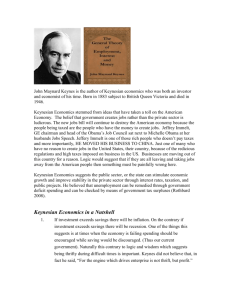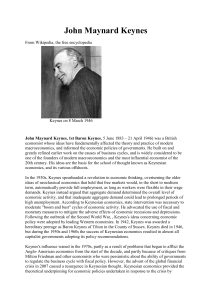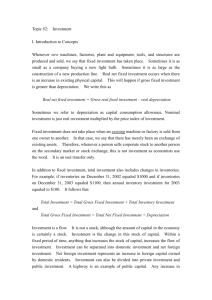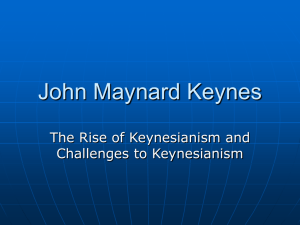Document 10464490
advertisement
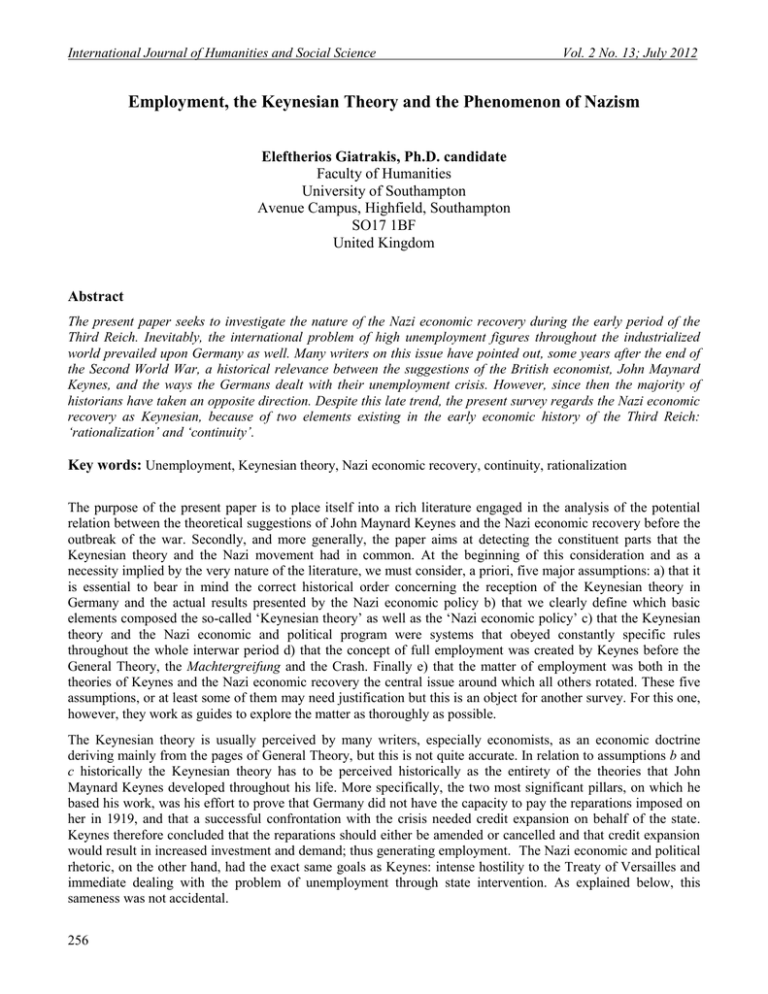
International Journal of Humanities and Social Science Vol. 2 No. 13; July 2012 Employment, the Keynesian Theory and the Phenomenon of Nazism Eleftherios Giatrakis, Ph.D. candidate Faculty of Humanities University of Southampton Avenue Campus, Highfield, Southampton SO17 1BF United Kingdom Abstract The present paper seeks to investigate the nature of the Nazi economic recovery during the early period of the Third Reich. Inevitably, the international problem of high unemployment figures throughout the industrialized world prevailed upon Germany as well. Many writers on this issue have pointed out, some years after the end of the Second World War, a historical relevance between the suggestions of the British economist, John Maynard Keynes, and the ways the Germans dealt with their unemployment crisis. However, since then the majority of historians have taken an opposite direction. Despite this late trend, the present survey regards the Nazi economic recovery as Keynesian, because of two elements existing in the early economic history of the Third Reich: ‘rationalization’ and ‘continuity’. Key words: Unemployment, Keynesian theory, Nazi economic recovery, continuity, rationalization The purpose of the present paper is to place itself into a rich literature engaged in the analysis of the potential relation between the theoretical suggestions of John Maynard Keynes and the Nazi economic recovery before the outbreak of the war. Secondly, and more generally, the paper aims at detecting the constituent parts that the Keynesian theory and the Nazi movement had in common. At the beginning of this consideration and as a necessity implied by the very nature of the literature, we must consider, a priori, five major assumptions: a) that it is essential to bear in mind the correct historical order concerning the reception of the Keynesian theory in Germany and the actual results presented by the Nazi economic policy b) that we clearly define which basic elements composed the so-called ‘Keynesian theory’ as well as the ‘Nazi economic policy’ c) that the Keynesian theory and the Nazi economic and political program were systems that obeyed constantly specific rules throughout the whole interwar period d) that the concept of full employment was created by Keynes before the General Theory, the Machtergreifung and the Crash. Finally e) that the matter of employment was both in the theories of Keynes and the Nazi economic recovery the central issue around which all others rotated. These five assumptions, or at least some of them may need justification but this is an object for another survey. For this one, however, they work as guides to explore the matter as thoroughly as possible. The Keynesian theory is usually perceived by many writers, especially economists, as an economic doctrine deriving mainly from the pages of General Theory, but this is not quite accurate. In relation to assumptions b and c historically the Keynesian theory has to be perceived historically as the entirety of the theories that John Maynard Keynes developed throughout his life. More specifically, the two most significant pillars, on which he based his work, was his effort to prove that Germany did not have the capacity to pay the reparations imposed on her in 1919, and that a successful confrontation with the crisis needed credit expansion on behalf of the state. Keynes therefore concluded that the reparations should either be amended or cancelled and that credit expansion would result in increased investment and demand; thus generating employment. The Nazi economic and political rhetoric, on the other hand, had the exact same goals as Keynes: intense hostility to the Treaty of Versailles and immediate dealing with the problem of unemployment through state intervention. As explained below, this sameness was not accidental. 256 © Centre for Promoting Ideas, USA www.ijhssnet.com Although it is not clear enough, and it has not yet attracted the attention of the scholars, the concept of continuity between the two World Wars functions as a historical bond between the Keynesian Revolution and the phenomenon of Nazism. Despite the fact that all the biographers of Keynes make references to his ‘dicta’ immediately after the end of the first World War and that the historians of the Nazi economy have claimed similarities on the way in which unemployment was overcome, there still lacks a point of view, among existing literature, that strongly emphasizes Keynesian influences in the economic problems that marked the history of the interwar period for Nazism. Therefore, the continuity between the wars, as a historic-economic system that worked automatically, is one of the two keys to explain why Keynes and Hitler had the same stance toward basic problems of their era and unconsciously used each other to deal with them. The literature that has denied a strong relevance between the Keynesian theory and Nazism is indeed quite old and large.1 Equally important is the one that has found traces to the opposite direction. Obviously, no writer has ever seriously doubted the prediction of Keynes in ‘The Economic Consequences of the Peace’, about the causes and occurrence of the Second World War. This prediction can be deemed to be the starting point and partially, (jointly with the full employment concept) the proof of the continuity. Full employment, as a driving force of modern societies, existed also in the ‘Consequences’ but it didn’t have then the prominence that it obtained during the late 1920s. Unemployment was still the main problem to be faced in early postwar Germany. However, due to the severity of the Great War, other issues monopolized the bulk of the common attention. The same happened with the main theme of Keynes’ book about the expected long-term outcome of the war. Keynes’ anti-reparations works had, naturally, a friendly reception in Germany by many economists and politicians. The analysis that he unfolded in his books after the war, especially in the ‘Consequences’ and the ‘Revision of the Treaty’, attempted to explain how Germany was going straight to another inflationary and economic crisis, which through the consequently unstable political situation, would result in a repetition of the Great War to an even larger scale. In an article of his on 26 July 1924, Keynes had predicted disaster unless the Dawes Plan was modified. He declared that Germany, in order to pay reparations, had to reduce wages of the German workers to such a point that political storm may follow, capable of destroying the Dawes plan.2 He had also seen in the post-war economy of Germany, elements of ‘rationalization’ that would fit his own system. This had to do with both the individual economists and the policies followed there.3 Rationalization, explained below, was the second key-element that brought the Keynesian theory and the official Nazi economic policy even closer together. Hjalmar Horace Greeley Schacht, German economist and twice president of the central bank of Germany (the Reichsbank) was very well aware of John Maynard Keynes and his writings. In 1930, when the symptoms of the global crisis had started to appear in Germany, and the Nazi party began to rise politically, Schacht made a statement attributing the spectacular elective successes of the Nazi party to the burden of reparations. Speaking at a luncheon given in his honor by the Board of Trade for German-American Commerce and the Institute of International Education, he pointed out the ‘incorrect ideas of the wealth of the German nation’ in regard to the matter of whether the Germans were earning enough to meet the reparations. Because of the general interest aroused there by the outcome of the German elections, with their large gains for the Fascist party, Schacht chose to discuss mainly the economic and political situation in Germany instead of the ‘Pan-European’ idea as scheduled. According to him, the injuries suffered by Germany following the war and the burden of reparation payments led to Hitlerism. If the payments should be met by taxes it would be necessary to tax away all income above $5,000 a year. Yet, among the population of over 60,000,000 only 33,000,000 had an income at all and half that did have an income earned less than $350 a year. Out of the remaining 16,000,000 only 80,000 people had an income above $5,000 a year and if these incomes were taxed away the economic leaders of Germany would hence leave the country. ‘This shows clearly’ Schacht continued ‘what ridiculous opinions exist as to Germany’s ability to pay’.4 Besides, it is well known that he had already and very early read the ‘Consequences’ of Keynes. The early 1930s marked a critical time in regards to the concept of ‘continuity’ for various reasons. Rationalization in the economic process had started5 at the same time as the crisis, along with a keener perception of the Keynesian full employment in Germany. 257 International Journal of Humanities and Social Science Vol. 2 No. 13; July 2012 According to some officials from the Reichsbank the causes of the crisis were going back to the First World War, for it was both the war and the peace settlement that created the global economic crisis, despite widespread notions that originated from the Wall Street Crash of 1929. In particular, the lost war gradually led to a considerable withdrawal of capitals from Germany, while the additional burden of the annual reparations had contributed to the appearance of riots and social disturbances. In addition, illiquidity in the crediting countries was another reason for the maintenance of the unemployment crisis. Definitely, Keynes was suggesting at that time what Germany lacked and desperately needed: capitals and low rates of interest.6 In regard to the assumption e, these factors represented some of the main bonds constituting the Keynesian continuity, driven from the reparations to the unemployment crisis and from the Paris peace conference to the invasion of Poland. Owing to all these facts that made Keynes believe in this necessity, many economists in Germany started, in the same way, to move toward the fulfilment of this prospect. The new president of the Reichsbank, Hans Luther, sought during July 1930 further loans in Paris and London, but these efforts were initially fruitless. Nevertheless, the attempts of Germany for a potential credit from abroad would continue in the future too. There was, without doubt, a mutual relation, as Keynes himself was intensively interested in the German economy over the duration of this period and the German audience were largely amused by his publications. Obviously, for Keynes the German economic basis had a critical role to play not only in the European but, as it was later proved, in the entire world economy. Links between him and many German economists and politicians were very soon established. Those links, according now only to the assumption b, were due to the reparations tangle and the derivative transfer problem over the 1920s, which afterwards were naturally extended to other economic issues as well. But the following question of unemployment in the German case should not only be connected to the Crash but, as it can easily be suspected and as it was correctly regarded by Reichsbank officials, it should be seen as a product of the reparations debt of Germany; the problem of unemployment was finally resolved not earlier than 1932, namely three years after the Crash and one year after the big rise of the unemployment figures there. On this matter, it is noteworthy to say that Keynes had sent a letter on 5 January 1929 to Professor Sering pointing out the significance of the foreign credits that Germany received in order to pay some of the installments of the reparations.7 Keynes eventually became a very well known figure in Germany since the publication of the ‘Consequences’ and all of his most significant works became equally known there. One and a half years before the rise of Hitler to power, a revisionist group was formed under the name ‘Society of studies for the Nature of Money and Credit’ in which outstanding members were Werner Daitz and Fritz Reinhardt with Gregor Straßer and Walther Funk keeping fine connections to it. This society was also linked with Keynes himself and Keynes visited Germany to give a lecture before them.8 Moreover, it is certain that his new suggestions of a deficit stimulus for work creation plans largely influenced the speech that Straßer held in Reichstag in May the same year.9 On this speech were later based official work creation plans of the Nazi state, in particular those proposed by Gereke and Reinhardt. It is also true that the works of Keynes, when published in Germany after January 1933, did not escape censorship and the same occurred with the works of his non Nazi disciples there; but this was not enough to prevent their spreading into the Third Reich. On the contrary, censorship may sometimes enforce instead of preventing the spread of ideas. In this way, some of the publications of Keynes appeared ‘unmolested’ by the regime and contributed to the ideological enforcement of the work creation plans.10 Thus, the circle of the economists and industrialists who endorsed this kind of thought became, in time, bigger. Furthermore, many of them collaborated with the Nazi government, firstly in recovering the German economy and later in realizing its expansionist goals. As a result, Keynes’ suggestions helped the formation of a group of individuals who favoured the prospect of fighting unemployment by measures of ‘deficit spending’. Lectures and meetings that would point out the significance of work creation by public works, financed by the state, were a very often occasion in the Third Reich.11 At the same time, a whole literature appeared to boost up ideologically the Keynesian struggle against unemployment.12 At the individual level, particularly significant was the presence and influence in early Nazi Germany of two distinguished figures, already mentioned above, officially responsible for drawing up the National socialist economic policy, namely Fritz Reinhardt and Hjalmar Schacht. 258 © Centre for Promoting Ideas, USA www.ijhssnet.com Both of them contributed a lot to the fight against unemployment while their plans, along with the policy that they later pursued, were both in content and in appearance of Keynesian style. Reinhardt was a consistent Nazi member and a fervent adherent and preacher of all ideological doctrines of the party. Anti-semitism and expansionism run through most of his writings in a mixture of practical suggestions and a semi-scientific way of thinking. He was the typical Nazi economist. In fact, Reinhardt had publicly recognized and declared that the reduction of high rates of unemployment was the critical problem for the then present and future of the German economy. He didn’t seem to be directly connected to the work of Keynes, or even more with Keynes himself, but there certainly were focal points on his work that, at least externally, were the same with previous Keynesian proposals. As state secretary of the Finance Ministry, Reinhardt was particularly willing to contribute to the construction of the Keynesian road of tax cuts in Germany (which was later expressed through the Gesetz über Steuererleichterlungen - law of 15 July 1933), which according to him had to be accompanied by a program of new expenses of debt prescription. It wouldn’t be a dilemma for Reinhardt to choose between lowering taxes and removing established social, economic and cultural arrangements. This was because the second option was not viable in the long run. In addition to his belief that the German state can effectively overcome unemployment through large-scale public works, a belief that can be characterized only as Keynesian, Reinhardt also believed in the fashion of his time for credit expansion and increased purchasing power. Furthermore, the economic ideology of Reinhardt was directly connected to all previous anti-unemployment programs of Papen’s and Schleicher’s governments, which were directly influenced by the Keynesian theory through Lautenbach and Wagemann. Reinhardt learnt from those plans to form later the basis of his own unemployment theory. Eventually, the whole of his administrative work inside the Ministry of Finance has to be historically deemed as another ideological expression of the Keynesian nature of the Nazi economic revival. It would not be an exaggeration for a historian to claim that the economic rhetoric of Reinhardt was the same, letter by letter, with the work of Keynes, regardless of the question of its ideological origin, which also happened to be at least indirectly Keynesian.13 The case of Schacht, as regards to the matter of his relation with Keynes and the Keynesian theory, has not yet been presented and analyzed as extensively as it should have been. Historically, he was deeply concerned about both pillars of the Keynesian theory, the reparations question and the unemployment crisis. He knew them thoroughly in a way that individually, he along with Hitler, expressed the concept of continuity better than any one else. On the one hand, Schacht helped transfer the Keynesian anti-reparation rhetoric to Germany in its most original form. On the other, although not a party member, he enjoyed the trust of Hitler and was vested with power enough to fight unemployment.14 They used to talk a lot with each other about the capitals Germany had to spend in order to eradicate unemployment and as he later admitted, unemployment was the reason for him to take over, after Hitler’s personal proposal, the leadership of the Reichsbank for a second term. Moreover, a deeper inspection into his ideological anatomy would lead to the conclusion that Schacht developed notions very similar with those of Keynes. It is not the fact that Schacht and Keynes had met and talked several times, agreed on what they had talked about or that they had both read each other extensively.15 It was the fact that they had almost identical views on the past, present and future policies of their countries and their common continent. Schacht had acknowledged, several times, that ‘the Keynesian theory of deficit spending is basically correct’,16 although he kept some reservations on the way of its application. It is true, Schacht was afraid of inflation and this inflationary fear of his may be seen as a non-Keynesian characteristic in the form of his ideology.17 Inflation in Germany since the war, had a twofold content: a) historical and b) psychological.18 The invention of Mefo bills by him was a scheme not to create money but to avoid this (negative) perspective, because overspending might lead to the historical phenomenon of 1923. But back in that time, the German state had not followed any policy of large-scale spending, let alone through a massive budgetary deficit. The basic reason that helped him overcome this fear was that almost all Nazi economists surrounding him in the Reichsbank and the Ministry were convinced that the financial support of the fight against unemployment was possible without any serious inflationary concession.19 In accordance with the assumption d, a conclusion that can be made is that Schacht represented the principal maker of the early Nazi economy, who was well aware of protoKeynesian anti-unemployment proposals and once he got over his inflationary misgivings he set about to achieve, consciously in a Keynesian way, the recovery of the depressed German economy. 259 International Journal of Humanities and Social Science Vol. 2 No. 13; July 2012 In the turning point from the first to the second part of the assumption a, which generally expresses the concept of ‘continuity’ and more particularly how the final transition from the field of theory to that of practical application occurred, at the very moment when the reparations were finally canceled, mention initially has to be made on three major plans by which the Nazis eventually dealt with the crisis after they assumed power: a) the Papen-plan b) the Sofortprogram and the c) Reinhardt program. All of them were ideologically influenced by Keynes and in addition, Gereke and Reinhardt, responsible for the design of the last two, belonged to the revisionist society under his strong influence.20 The main impact that Keynes had on these plans can also be detected on their ‘pumppriming’ character, in other words they were designed to give a stimulus to the upward curve of the business cycle and kindle the first spark after which the private sector would restore its previous capacity to carry on the recovery initiated by the state.21 In the middle of the ‘continuity’ line, namely when those plans were started by the German state, the rationalizing bond between the ‘Keynesian Revolution’ and the ‘Nazi movement’ was considerably intensified. The tools offered by Keynes were taken by the Nazis in their attempt to practically apply a formal knowledge to their aim of abolishing unemployment. For this very reason and bearing in mind, at the same time, the assumption c, it is essential to state that all work creation schemes the Nazis introduced in 1933 onwards obeyed the concept of rationalized labour. Namely a work system that was dependent on a set of published rules. This system of rules was none other but the one Keynes created with his theoretical proposals. The mechanic way of operation of these rules presented later on in the General Theory was the same with the mechanically marching way of the inter-war continuity from the end of the First, to the start of the Second World War. Eventually, the need for a more rationalized dealing with these major problems was the reason for the Nazis to direct their attention to Keynes.22 Another basic condition of Keynes was that when the state needed money to spend, only credit, was the way out of the problem, be it foreign or internal; plans for a credit expansion were being made, a little before the rise of Nazism to power, by Lautenbach and Woytinsky.23 After Nazism’s assumption of power, Hitler did exactly as he was advised when his official government signed, in 1933, an extension of a previous agreement (‘the Second Standstill Agreement’) with bank institutions from the USA, Belgium, Czechoslovakia, Denmark, England, France, Holland, Italy, Sweden and Switzerland.24 Receivers of this credit on behalf of the German state were the Reichsbank and the Deutsche Golddiskontbank. Together with the foreign capitals that flew into Germany, devices were invented for the production of more money desperately needed to fight unemployment. The main individuals that allocated and directed investment of the acquired capitals were Schacht and Schwerin von Krosigk, while the financing process took the form of the Reichsbank fueling the Reich Finance Ministry with funds.25 Once the budget was boosted with more and sufficient amounts of money, the German state started to spend vigorously. Public works became a priority while unemployment benefits, favored by the previous governments, were kept on but to a lesser degree.26 In any case, both public works and allowances stood high on the agenda of Keynes’ suggestions. Out of the tables provided at the end of the paper, an essential conclusion that has to be made is that over the early anti-unemployment period, the multiplier between initial and secondary employment was considerably higher, reaching at times the ratio 1:8. Between January 1933 and January 1934, the most indicative period since the insertion of money into the economy had formally an annual character, the multiplier grew even higher regardless of the secondary employment that developed in the armament industry. The fact that the Keynesian multiplier worked efficiently in the Nazi Germany was another strong reflection of the now fully rationalized German economy.27 Another sign of the high ratio can be seen as the year changes where, while funds are decreasing, the employment figures were multiplying. Simultaneously, the foreign debt of Germany remained and as of April 1934 it had increased to 6 billion Reichsmarks. It was the exact same amount of money by that time spent, as above shown, for the civilian fight against unemployment. Individually, an official from the Reich Finance Ministry, Dr Olscher, proposed on 25 June 1934 a new state credit for the creation of even more jobs. Olscher saw the inflationary dangers behind extensive money-printing as this had been seen in Germany with the exceeding equivalent value of the already existing stock in consumer goods at the time when the product of the existing lack of goods was at a lower price than the rhythm of the expansion of credit. Olscher went on stating that, although inflation will bring about slump, the reclamation of credit will later result in deflation and for this reason the ministry has to continue its credit creation policy.28 260 © Centre for Promoting Ideas, USA www.ijhssnet.com Indeed, according to Nazi intentions the expansion of credit had to go along with higher rates of production and larger salaries, in order to increase civilian purchasing power and consumption.29 This was another undeniable reflection of the Keynesian theory on the Nazi plans and deeds. Furthermore, Goering testified in Nuremberg that over the early period of rearmament, the increased purchasing power of the workers brought ‘a tremendous demand for consumer goods’.30 Keynes had already unfolded, in his General Theory that increased demand would develop into ‘aggregate’ after state expenses.31 Hitler would later emphasize in a speech of his, that the Nazi economic program was not so much a financial program, but a program of production.32 Indeed, consumption as a result of higher production, employment, and of course wages was at a significantly higher level. This was because, until the inauguration of the Four Year Plan, when the Nazi economists decided to highly accelerate the rhythm of armaments production at the expense of private consumption, the latter had followed an upward direction reaching approximately the 1929 level. Therefore, it would be very hard for a historian to deny that this fact functioned as another Keynesian sign of the way the Nazis recovered their economy.33 However, consumption for Keynes would not be the most decisive element toward full employment. Deficit spending, as the beginning toward this goal, certainly took more gravity on his theoretical constructions and the same occurred with the Nazi economic recovery.34 For Hitler had decided to spend a lot of money to pave his way fully open and realize his plans. At the beginning of the war, he personally estimated the overall expenses for armament purposes to the amount of 90 billion Reichsmarks. 35 The whole expenditure of the Third Reich before the war was grosso modo 120 billion Reichsmarks. This expenditure produced a huge Keynesian deficit. Public works and rearmament had, as a result the emergence of a big state into the economy while the private sector was content with a secondary role: the so-called ‘primacy of politics’. After all, Keynes was keenly aware of the possibility that public works and other state spending might displace private investment.36 In addition, the money which flowed into the economy was escorted by low rates of interest and more rationalization of the factories while the greatest part of the private industry along with the nationalized one, had finally imposed a functional mode through which more production could be achieved by spending the least available money. 37 In view of another specialized aspect of the assumption e, this was another reflection of how the Keynesian multiplier operated satisfactorily in the case of the German recovery. However, in 1938 Schacht was calling upon a stop to new investment and state spending.38 The content of this necessity and the fact that, by that time he had no significant power to make policy, do not necessarily imply a non Keynesian direction for the German state. In fact, the opposite was true. Reichsbank was now fighting inflation with deflation by taking back funds given to the work creation programs, owing to the very fact that their pump priming function had already fulfilled its mission and wages were increasing yet again. This was precisely what Keynes had suggested two years earlier.39 More inflation would have been a reason for less employment and more taxation, and this surely cannot be a Keynesian viewpoint, because otherwise it would have been contrary to the ‘pump-priming’ substance of his theory.40 An overall assessment of the kind and nature of the Nazi economy during the early stage of the Third Reich leads us directly and without doubt to conclude that everything in the Nazi economic recovery was of Keynesian style. Even for the constitutional question, Keynes had left a political door open so that his system would fit, and work well with Hitler’s one.41 Besides, politics doesn’t actually affect the applicability of the Keynesian theory; it may be applied on many differentiated occasions, as it did in the case of the Nazi economic recovery. Certainly though this fact is not the actual point deriving from this paper. For in order to thoroughly understand why the Nazi economic recovery was, both in letter and in spirit, Keynesian we have to see it, in regard to the assumptions a and c through an overview of the inter-war period that would reveal to its full size the concept of ‘continuity’. The continuity means that the unemployment crisis in Germany had its roots in and was created by the reparations problem a decade earlier, with the American crash being able to only function as a mere intensification of the German boom. In fact, the German crisis had a very few things to share with the American one because it obeyed its own rules of development, namely the rules of Keynes. Because of the other fact, that the identical Keynesian and Hitlerian systems on viewing economic development were such, that according to the systemic theory each element of them had to work in accordance with the others, the process of the interwar period moved step by step toward the fulfillment of continuity in a way that all of the major economic and political issues of the period were, in conformity, co-working parts of these systems. 261 International Journal of Humanities and Social Science Vol. 2 No. 13; July 2012 The Nazi economic recovery was just one of them. From the very beginning, what full employment meant for Keynes was, for Hitler, full mobilization to go from the one war to the other. This is why generally, the Nazi economic recovery was of Keynesian style and why Europe lived the experience of two massive wars. Table 1: The cost of Unemployment* Fiscal year 1932/33 1. Unemployment benefit (incl. short-time workers) 2. Crisis benefit 3. Unemployment social security Sum total: net state aid for unemployment (million Reichsmarks) 534,7 884,9 1 392,7 2 812,3 1933/4 1934/35 249,2 777,6 1 229,2 251,5 535,9 756,7 2 256,0 1 544,1 *Schiller K., Arbeitsbeschaffung und Finanzordnung in Deutschland (Berlin, 1936), p. 152 Table 2: Development of Employment in Public Works** January 1933 ……………………23,665 February 1933……..…………….36,707 March 1933……………………...88,041 April 1933…………………...…113,852 May 1933……………………….120,842 June 1933……………………….144,933 July 1933…………………..…...140,126 August 1933…………………….186,551 September 1933…………………232,445 October 1933……………………314,487 November 1933…………………400,847 December 1933………….………277,484 January 1934…………….………383,275 February 1934…………….……..507,384 March 1934…………………….. 630,163 April 1934………………….…...601,507 May 1934…………….………….502,362 June 1934……………….………392,433 **Baerwald F., ‘How Germany reduced unemployment’, The American Economic Review, 24, 4 (December, 1934), p. 623 262 © Centre for Promoting Ideas, USA www.ijhssnet.com Notes: 1 on constitutional grounds Erbe R., Die Nationalsozialistische Wirtschaftspolitik 1933-1939 im Lichte der moderne Theorie (Zürich, 1958), pp. 168-170; on the grounds of the historical events sequence Buchheim C., ‘Das NS-Regime und die Überwindung der Weltwirtschaftskrise in Deutschland’, Vierteljahrshefte für Zeitgeschichte (hereafter VfZ), 56, 3, (Juli 2008), pp. 381-2 and again Buchheim C., ‘Die Wirtschaftsentwicklung im Dritten Reich-mehr Desaster als Wunder Eine Erwiderung auf Werner Abelhauser’, VfZ, 49, 4, (Oktober 2001), p. 657; on the grounds of inexistence of tax stabilisers Ritschl A., ‘Deficit Spending in the Nazi Recovery, 1933-1938: A Critical Reassessment’, Journal of the Japanese and International Economies, 16, 4, (2002), p. 577; on the grounds of consumption and high rates of interest Overy R., The Nazi economic recovery 1932-1938 (Cambridge, 1996), pp. 50-1; on the grounds of unemployment as a non central economic issue of the recovery Tooze A., The Wages of Destruction The Making and Breaking of the Nazi Economy (London, 2006), pp. 32-33 and James H., ‘What is keynesian about deficit financing? The case of interwar Germany’, P. A. Hall (ed.) The political power of economic ideas: Keynesianism across nations (New Jersey, 1989), pp. 243, 261, on the grounds that the multiplier was low 2 Historisches Archiv der Deutschen Bank (hereafter HADB), A0138, Amerikanische Zeitungsausschnitte über Deutschland, vol. 2 Berichtszeitraum: 1.1.1924-31.12.1930; the article was published in the ‘Wall Street Journal’ 3 Kalka J. und Hauser D., John Maynard Keynes Freund und Feind Zwei Erinnerungen (Berlin, 2004), p. 19 4 HADB, Ibid., article in Herald Tribune on October 4, 1930 entitled ‘Schacht lays rise of Hitler to reparations Fascist workers’ answer to realization they, too, must help pay, he says’. He had a few months before he resigned from his first and longest term in the presidency of the Reichsbank. Later the same year he predicted the abolition of the reparations and defended Hitlerism as a ‘perfectly constitutional movement’; on the matter of the economic independence of Germany among the other european countries Schacht H., Nationale Kreditwirtschaft (Berlin, 1934), p. 10; about the derivative of the reparations ‘transfer problem’ Keynes J. M., ‘The German Transfer Problem’, The Economic Journal, 39, 153 (Mar, 1929), pp. 1-7 and the reply of Schacht to Keynes about it J. M. Keynes, The Collected Writings of John Maynard Keynes (hereafter CW), vol. 18, p. 311 5 Bundesarchiv-Berlin, Lichterfelde (hereafter BA), R 2501/1016/20 article entitled ‘La situation économique de l’ Allemagne et les réparations’ Rationalization meaning the practical application of knowledge to achieve a desired end, an attempt to change a pre-existing ad hoc workflow into one that is based on a set of published rules; also BA, R 2501/6787/246 the writing of Hermann Schneider, ‘Unser täglich Brot. Lebensfragen der deutschen Landwirtschaft’, where rationalization was expressed as another ideological intention of the German administration. The starting point of this process was the same with the intensification of the insertion of Keynes’ anti-unemployment theories in Germany. 6 BA, R 2501/6492/I/2-5 article entitled ‘Zur Entwicklung der gegenwärtigen Finanzkrise Deutschlands - Die Ursachen der Krise’; Diehl K., ‘Die Ursachen des hohen Kapitalzinfußes in Deutschland’, Hrsg. Karl Diehl, Wirkungen und Ursachen des hohen Zinfußes in Deutschland (Jena, 1932), p. 884; Dimand R., The Origins of the Keynesian Revolution The Development of Keynes’ Theory of Employment and Output (Aldershot, 1988), p. 10 7 BA, R 2501/6724/388; for the reception of Keynes in Germany before 1933 see Garvy G., Keynes and the Economic Activists of Pre-Hitler Germany, The Journal of Political Economy, 83, 2 (Apr.1975), pp. 397-398 and Akten zur Deutschen Auswärtigen Politik 1918-1945, Serie A: 1918-1925 Band IV, Vandenhoeck & Ruprecht in Göttingen, p. 335 8 Dräger H., Arbeitsbeschaffung durch produktive Kreditschöpfung, Neudruck einer Schrift von 1932 mit Stellungsnahmen von H. Brüning und H. Luther aus den Jahren 1953/54 (Düsseldorf, 1932), pp. 31-32; Kissenkoetter U., Gregor Strasser und die NSDAP (Stuttgart, 1978), pp. 90-1, 105-109 9 Fischer A., Hjalmar Schacht und Deutschlands ‘Judenfrage’ Der ‘Wirtschaftsdiktator’ und die Vertreibung der Juden aus der deutschen Wirtschaft (Köln, 1995), p. 79; Stachura P., Gregor Strasser and the rise of Nazism, (London, 1983), p. 98, the so-called ‘Work and Bread’ speech. 10 Schumpeter J., History of economic analysis (New York, 1954), p. 1156; Borchardt K., ‘Keynes’ «Nationale Selbstgenügsamkeit» von 1933 Ein Fall von kooperativer Selbstzensur’, Zeitschrift für Wirtschafts- u. Sozialwissenschaften, 108, (1988), pp. 271, 277-8 11 BA, R 2501/6608/143; Czichon E., Wer verhalf Hitler zur Macht? Zum Anteil der deutschen Industrie an der Zerstörung der Weimarer Republik (Köln, 1976), pp. 26, 31-5 263 International Journal of Humanities and Social Science Vol. 2 No. 13; July 2012 Some examples could be Wrede V., ‘Finanzierungsprobeme in neuen Abschnitt der Arbeitsschlacht’, pp. 74-79, Die nationale Wirtschaft, 4, 3, (1936) and Kretzschmann H., ‘Arbeitsschlacht und Reichsbank’, Die Staatsbank, 2, 12, (1935) and some publications that focused on the way the state should spend money out of the budgetary balance appeared in the Vierteljahrshefte zur Konjukturforschung, ‘Neues Stadium der Finanzierung’ 10, 2 (1935), Teil A, pp. 188-194; ‘Zur Frage der Finanzierung’, 10, 3 (1935), Teil A, pp. 310-314 and ‘Grundlagen und Grenzen der Kreditausweitung’, 10, 4 (1936), Teil A, pp. 428-435; about the work creation schemes and the higher consumption rates Schacht H., ‘Finanzwunder und Neuer Plan’. Vortrag des Reichsbankpräsidenten Dr. Hjalmar Schacht vor dem Wirtschaftsrat der Deutschen Akademie (Berlin, 1938), p. 8; a suggestion that some credit machineries have to be reactivated by which new capital should arrive Dessauer F., Im Kampf mit der Wirtschaftskrise Gemeinverständliche Darstellung der Wirtschaftslage und der Möglichkeiten ihrer Überwindung (Frankfurt a. M., 1932), pp. 79, 85 13 BA, R 2501/6787/241-242 where there is a writing of Reinhardt entitled ‘Die Herrschaft der Börse’ in the collection of the ‘Schriften der Nationalsozialistischen Bibliothek’, later published. Also Reinhardt F., Finanz und Steuerpolitik im nationalsozialistischen Staat (Berlin, 1934), pp. 5, 6 ff., 24; Reinhardt F., Die Beseitigung der Arbeitslosigkeit im Dritten Reich Das Sofortprogramm 1933/34 Hrsg. Wittrich R., (2006), pp. 5, 23, 55, 74; Reinhardt F., Was geschieht mit unserem Geld? Finanzen Kaufkraft Währung (Nürnberg, 1942), pp. 38-40; Krosigk L.G.S. von, Memoiren (Stuttgart 1977), pp. 161-163, which is a very good source about the employment and labour ideology of Reinhardt. See also on this Silverman P. D., Hitler’s Economy Nazi Work Creation Programs, 1933-1936 (Cambridge, 1998), p. 146 on the Keynesian way Reinhardt saw taxes in Germany. 14 The National Archives, Kew, Richmond, Surrey (hereafter TNA), CAB, 24/259/79 15 Pentzlin H., Hjalmar Schacht Leben und Wirken einer umstrittenen Persönlichkeit (Berlin, 1980), pp. 12, 47, 191-192; Harrod R., The life of John Maynard Keynes (London, 1951), p. 394 16 Schacht H., The magic of money (Oldbourne and London, 1967), p. 217 17 BA, R 2501/1017/129; see also on this Einzig P., Germany’s default The economics of Hitlerism (London, 1934), p. 41 and Simpson A., Hjalmar Schacht in Perspective, (Hague and Paris, 1937), p. 126; as Einzig colorfully points out the choice was not between inflation or default, but between default as the result of inflation. Again from the Reichsbank a suggestion that work creation schemes inevitably involve some inflation BA, R 2501/6788/113 18 BA, R 2501/1016; in regards to the last two assumptions on the relation between inflation and employment through a Keynesian point of view see also Jones A., ‘Inflation as an Industrial Problem’, (ed.) R. Skidelsky, The End of the Keynesian era Essays on the disintegration of the Keynesian political economy (London and Basingstoke, 1977), p. 53 ff.; Schacht later pointed out how important the change of psychology of the German businessman was on the economy in general regarding measures that concerned prices control and foreign trade. Schacht H., Deutschland in der Weltwirtschaft Vortrag des mit der Führung der Geschäfte des Reichswirtschaftsminister beauftragten Reichsbankpräsident Dr. Hjalmar Schacht auf der Leipziger Frühjahrsmesse (Leipzig, 1935), p. 26 19 BA, R 2501/6496; some later statements of his that money creation does not always bring inflation with a simultaneous mention on Keynes Schacht H., Mehr Geld, mehr Kapital, mehr Arbeit (Bleckede, 1950), pp. 59, 29, 63; nothing in the thought and practice of Schacht was non Keynesian. About the credit policy he proposes Schacht H., ‘Kaufmänisches Denken tut der Welt not!’, Der deutsche Volkswirt, 9, 38 (1935), p. 1757; for the diffusion in Germany of Keynes’ idea that it was possible to shorten the road to recovery without destabilizing the currency Röpke W., ‘Trends in German Business Cycle Policy’, The Economic Journal, 43, 171 (1933), p. 436 20 Also notable is the fact that the ‘Sofortprogram’ made provision that the credits to the industry were to be of zero rate of interest K. Lehmann, Wandlungen der Industriefinanzierung mit Anleihen in Deutschland (1923/241938/39) (Stuttgart, 1996), p. 21 21 Grebler L., ‘Work Creation Policy in Germany, 1932-1935: I’, International Labour Review, 35, 3 (March, 1937), p. 331; the Papen- and Sofort-plan had cost the Reich budget both together 1 billion Reichsmarks; for the Reinhardt program the German state spent the double of each, 1 billion Reichsmarks. BA, R 2/18418/F. 2, Schwerin von Krosigk (19 May 1937) to Dr Krohn, state secretary of the Reich Labour Ministry; see also on this the relevant article of July 30, BA, R 2/18418/F.4 and Keynes J. M., CW, vol. 9, p. 108 12 264 © Centre for Promoting Ideas, USA www.ijhssnet.com 22 Bundesarchiv-Militärarchiv, Freiburg, (hereafter BA-MA), RH 2/2994 article about the influence of the Treaty of Versailles and the technical and economic development of the German industry since the end of WW I to the war economic basis of Germany, March 1933, pp. 10, 35, 37 (archival page reference-the document lags behind two pages respectively) - Keynes is being mentioned at page 10 (8 of the document); Quante P., ‘Arbeitsbeschaffung und Rentabilität’, Schmollers Jahrbuch, 57, 1 (1933), p. 50; Guillebbaud C. W., The economic recovery of Germany (London, 1939), p. 215 ff.; Thamer H. U., Verführung und Gewalt Deutschland 1933-1945 (Berlin, 1986), p. 471; Vomfelde W., Abschied von Keynes? Eine Antwort auf die monetarischneoklassische Gegenrevolution (Frankfurt, 1985), pp. 13 ff., p. 88 23 BA, R 2501/6496; Woytinsky had made estimation that a needed capital of 2 billion Reichsmarks would bring about a reduction of 2 million unemployed Germans. It was the sum of money that Keynes had proposed in the ‘Consequences’ as the proper annual reparations payment that Germany should pay to the Allies. Keynes, CW, vol. 2, p. 93 24 ʽin order to insure maintenance of the financial stability of Germany, which is essential in the interest of the whole world’; BA, R 2501/7522 25 BA, R 2/18417/F. 2 Report of Schwerin von Krosigk for the financing of the unemployment allowance on 16 January 1935 - about the funding function of the Reichsbank see also Bresciani Turroni C., ‘The «Multiplier» in practice: some results of recent German experience’, The Review of Economic Statistics, 20, 2 (May 1938), p. 86 26 National Archives and Records Administration, College Park, Washington DC (hereafter NARA), RG 165, SA 390, row 35, compartment 15, shelf 07, box 2, folder Hermann Göring, Reichsmarshall, 24 July 45, Schuster, Interrogation of H. Goering, first page; BA, R 2/18408/7 report of Dr Heide, head of the responsible office (May 1942) and most of all the report of S. von Krosigk BA, R 2/18416/5 on the authorization of another welfare allowance on 15 May 1933 to the amount of 130,4 million Reichsmarks 27 BA, R 2/13716/204-5; about the multiplier here see comparatively Kahn R., ‘The relation of Home Investment to Unemployment’, The Economic Journal, 41, 162 (June 1931), pp. 192-3; Rymes T., Keynes’s Lectures, 193235 Notes of a representative student (Basingstoke and London), 1989, pp. 117, 118; Keynes J. M., CW, vol. 7, p. 119; Bresciani Turroni C., ‘The «Multiplier» in practice: some results of recent german experience’, Ibid., pp. 7879, Haberler G., ‘Mr. Keynes’ Theory of the ‘Multiplier’’, Zeitschrift für Nationalökonomie, 7, 3 (1936), p. 303; Bortis H., ‘The multiplier relation as the pure theory of output and employment in a monetary production economy’, (eds) Claude Gnos & Louis-Philippe Rochon, The Keynesian multiplier (N. York, 2008), p.72; Patinkin D., ‘Keynes and the Multiplier’, Manchester School of Economics and Social Sciences, 46, 3 (September, 1978), pp. 209-223 28 BA, R 2/13718/139-40 mentioning at the same time the historical example of the 1928/1930 and the deflation of 1931/32; additionally on the stocks of goods in relation to the rationalized expansion of capital with a correspondent depreciation of allowances as they were replaced for more public investment Bresciani Turroni, ‘The «Multiplier» in practice: some results of recent German experience’, Ibid., p. 79; on the pros and cons of money printing see also BA, R 2/13716/179 (report in which central role takes ‘der goldene Pfennig’) 29 BA, R 2/13718/135 (page 2 in the report of 21 June 1934 written Otto Landmann) 30 NARA, RG 165, SA 390, row 35, compartment 15, shelf 07, box 2, Ibid., p. 2 31 In a combining mixture of the assumptions d and c respectively. 32 TNA, CAB 24/275, Memorandum of Maurice P.A. Hankey; the speech of Hitler was given on February 20, 1938 33 Nathan O., The Nazi Economic System Germany’s mobilization for War (Durham, 1944), p. 364; Buchheim C., ‘Die Wirtschaftsentwicklung im Dritten Reich’, Ibid., p. 656; as Buchheim stresses private consumption was increased in 1933 and 1934 to 9% per person; BA-MA, RH 2/2994/29 with a clear mention that more rationalization led to more production and employment. Also Schacht H., ‘Finanzwunder und Neuer Plan’, Ibid., p. 8; about the personal intentions of Hitler for more private consumption Kluke P., ‘Hitler und das Volkswagenprojekt’, VfZ, 8, 4 (1960), pp. 346, 373 265 International Journal of Humanities and Social Science Vol. 2 No. 13; July 2012 A critical assessment of consumption’s right position in Keynes’ theory Skidelsky R., ‘Keynes’s political legacy’, (eds) Hamouda O. & Smithin J., Keynes and Public Policy After Fifty Years, 2 vols., vol. 1: Economics and Policy (Aldershot and N. York, 1990), p. 25 and Keynes J. M., CW, vol. 27, p. 319 35 BA, R 2501/7008/338 (page 6 of the document entitled ‘Nationalsozialistische Finanzpolitik in Gegenwart und Zukunft’); Keynes had previously suggested that spending on armaments is necessary for the accomplishment of increased employment. Kahn R., The Making of Keynes’ General Theory (Cambridge, 1984), p. 94; this was another expression of the ‘continuity’ line in accordance with the assumption c about how the reparations produced unemployment in Germany. Mantoux also stated the same number with Hitler (15 billion Reichsmarks annually) in a reversed interpretation of the identification between the Hitlerian and the Keynesian continuity Mantoux E., The Carthaginian Peace or The Economic Consequences of Mr. Keynes (London, 1946), p. 194 36 Bateman R.W., ‘Rethinking the Keynesian Revolution’, (ed.) John B. Davis, The state of interpretation of Keynes (Boston, 1994), p. 108 and about the German example Samuel Lurie, Private Investment in a controlled economy Germany, 1933-1939 (N. York, 1947), pp. 22-3 37 the core of the rationalization theory BA, R 2/18528/F. 2 article entitled ‘Besprechung zwischen Herrn Minister und Reichkommissar Gauleiter Bürckel am 14. November 1935’; they were talking about the region of Saar as the exception of the rest of rationalized Germany. On how increased production was achieved TNA, CAB 66/45/41 Memorandum entitled ‘The International Economic History of the Inter-War Period, (by John Anderson), pp. 181-182; about the interest rates Maurice de Saint-Jean, La politique économique et financière du Troisième Reich L’œuvre du Docteur Schacht (Paris, 1936), p. 122 making mention of a 4 per cent low in the credits given to the work creation schemes 38 BA, R 2501/1017/129 39 Keynes J. M., CW, vol. 7, pp. 118-9 40 Keynes J. M., CW, vol. 9, pp. 108-117 41 Keynes J. M., CW, vol. 7, p. xxvi 34 266

